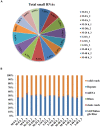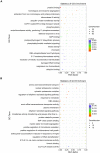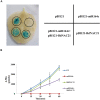Integrated Analysis of MicroRNA and Target Genes in Brachypodium distachyon Infected by Magnaporthe oryzae by Small RNA and Degradome Sequencing
- PMID: 34659311
- PMCID: PMC8517397
- DOI: 10.3389/fpls.2021.742347
Integrated Analysis of MicroRNA and Target Genes in Brachypodium distachyon Infected by Magnaporthe oryzae by Small RNA and Degradome Sequencing
Abstract
Rice blast caused by Magnaporthe oryzae is one of the most important diseases that seriously threaten rice production. Brachypodium distachyon is a grass species closely related to grain crops, such as rice, barley, and wheat, and has become a new model plant of Gramineae. In this study, 15 small RNA samples were sequenced to examine the dynamic changes in microRNA (miRNA) expression in B. distachyon infected by M. oryzae at 0, 24, and 48 h after inoculation. We identified 432 conserved miRNAs and 288 predicted candidate miRNAs in B. distachyon. Additionally, there were 7 and 19 differentially expressed miRNAs at 24 and 48 h post-inoculation, respectively. Furthermore, using degradome sequencing, we identified 2,126 genes as targets for 308 miRNAs; using quantitative real-time PCR (qRT-PCR), we validated five miRNA/target regulatory units involved in B. distachyon-M. oryzae interactions. Moreover, using co-transformation technology, we demonstrated that BdNAC21 was negatively regulated by miR164c. This study provides a new approach for identifying resistance genes in B. distachyon by mining the miRNA regulatory network of host-pathogen interactions.
Keywords: Brachypodium distachyon; Magnaporthe oryzae; high-throughput sequencing; miRNA; target.
Copyright © 2021 Peng, Song, Li, Yan, Huang, Yang, Duan, Dai and Wang.
Conflict of interest statement
The authors declare that the research was conducted in the absence of any commercial or financial relationships that could be construed as a potential conflict of interest.
Figures








Similar articles
-
Multiple rice microRNAs are involved in immunity against the blast fungus Magnaporthe oryzae.Plant Physiol. 2014 Feb;164(2):1077-92. doi: 10.1104/pp.113.230052. Epub 2013 Dec 13. Plant Physiol. 2014. PMID: 24335508 Free PMC article.
-
Parallel analysis of RNA ends enhances global investigation of microRNAs and target RNAs of Brachypodium distachyon.Genome Biol. 2013 Dec 24;14(12):R145. doi: 10.1186/gb-2013-14-12-r145. Genome Biol. 2013. PMID: 24367943 Free PMC article.
-
High-Throughput Sequencing Reveals H2O2 Stress-Associated MicroRNAs and a Potential Regulatory Network in Brachypodium distachyon Seedlings.Front Plant Sci. 2016 Oct 20;7:1567. doi: 10.3389/fpls.2016.01567. eCollection 2016. Front Plant Sci. 2016. PMID: 27812362 Free PMC article.
-
Comparative Analysis of Transcriptome and sRNAs Expression Patterns in the Brachypodium distachyon- Magnaporthe oryzae Pathosystems.Int J Mol Sci. 2021 Jan 11;22(2):650. doi: 10.3390/ijms22020650. Int J Mol Sci. 2021. PMID: 33440747 Free PMC article.
-
Comparative transcriptome analysis reveals distinct gene expression profiles in Brachypodium distachyon infected by two fungal pathogens.BMC Plant Biol. 2021 Jun 30;21(1):304. doi: 10.1186/s12870-021-03019-0. BMC Plant Biol. 2021. PMID: 34193039 Free PMC article.
Cited by
-
Genome-wide analysis of miR172-mediated response to heavy metal stress in chickpea (Cicer arietinum L.): physiological, biochemical, and molecular insights.BMC Plant Biol. 2024 Nov 12;24(1):1063. doi: 10.1186/s12870-024-05786-y. BMC Plant Biol. 2024. PMID: 39528933 Free PMC article.
-
Analyzing the defense response mechanism of Atractylodes macrocephala to Fusarium oxysporum through small RNA and degradome sequencing.Front Plant Sci. 2024 Jul 22;15:1415209. doi: 10.3389/fpls.2024.1415209. eCollection 2024. Front Plant Sci. 2024. PMID: 39104842 Free PMC article.
-
Integrative transcriptomic, proteomic, and phosphoproteomic analysis on the defense response to Magnaporthe oryzae reveals different expression patterns at the molecular level of durably resistant rice cultivar Mowanggu.Front Plant Sci. 2023 Jul 13;14:1212510. doi: 10.3389/fpls.2023.1212510. eCollection 2023. Front Plant Sci. 2023. PMID: 37521912 Free PMC article.
-
BrUFO positively regulates the infection of Chinese cabbage by Plasmodiophora brassicae.Front Plant Sci. 2023 Mar 9;14:1128515. doi: 10.3389/fpls.2023.1128515. eCollection 2023. Front Plant Sci. 2023. PMID: 36968418 Free PMC article.
-
Identification and characterization of pathogenicity-related genes of Rhizoctonia solani AG3 during tobacco infection.Front Plant Sci. 2023 Jan 17;13:1116506. doi: 10.3389/fpls.2022.1116506. eCollection 2022. Front Plant Sci. 2023. PMID: 36733585 Free PMC article.
References
-
- Cass C. L., Peraldi A., Dowd P. F., Mottiar Y., Santoro N., Karlen S. D., et al. (2015). Effects of PHENYLALANINE AMMONIA LYASE (PAL) knockdown on cell wall composition, biomass digestibility, and biotic and abiotic stress responses in Brachypodium. J. Exp. Bot. 66 4317–4335. 10.1093/jxb/erv269 - DOI - PMC - PubMed
LinkOut - more resources
Full Text Sources
Research Materials

